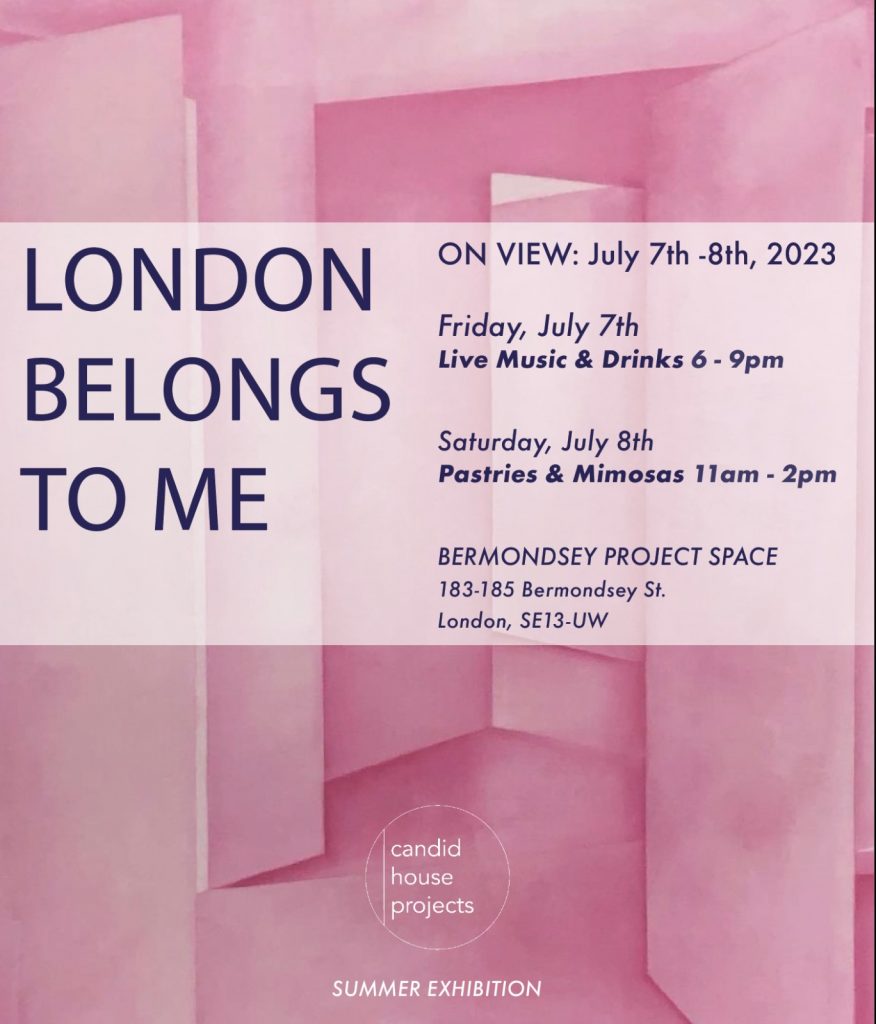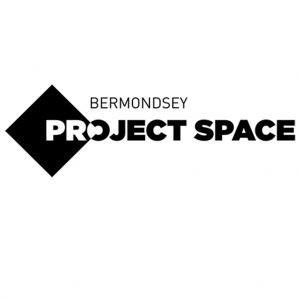7 – 8 July 2023
Opening Reception: Friday 7th July, 6-9pm
Pastries & Mimosas: Saturday 8th July, 11am to 2pm
Candid House presents their summer exhibition ‘London Belongs To Me’. This exhibition showcases what is being created in London today, show across three generations of artists : recent RCA and City Guilds Graduates, young but established painter Rex Southwick, Tate exhibited Ptolemy Mann, and iconic British artist Michael Challenger.
Exhibiting artists:
Ji Won Cha | Michael Challenger | Phoebe Evans | Beau Gabriel | Ptolemy Mann | Alice Mansfield | Jemima Murphy | Rex Southwick

Candid House Projects collaborates with artists on curated exhibition projects that showcase historical, established and emerging contemporary artists. Candid House Projects continuously creates online presentations and exhibitions to meet the range of collectors we work with around the world.
Several times a year, they curate pop-up exhibitions in targeted locations in order to bring the artworks to the areas and people we are connected to.
Ji Won Cha
Ji Won Cha (b. 1997, South Korea) is an artist based in London. In 2020 she graduated from the Rhode Island School of Design with a BFA in Painting, and is now graduating the MA painting programme at The Royal College of Art.
Her practice focuses on re-articulating the sublime in the 21st century. This re-articulation concentrates on what evokes the feeling of sublimity and finds a way to process these complex emotions of uncertainties that hold a place both in our personal lives and in a bigger construction of society. She has coined the term “The Anxious sublime” to describe her practice. It is a way to capture the intricate emotions that swell up during this elongated moment of anticipation where one hopes for the future to arrive. The “future” that is supposed to happen. With the contemporary world overflowing with excesses of information at a digital hyper-speed, our coping mechanism is degraded, and we lose our ability to differentiate fact from fiction. The information that we access accumulates and forms a massive cloud of data, yet we still cannot find a definite answer. What is destined to occur in this ever-changing world? What is it that we are so eagerly waiting for to happen? The feelings that escalate when we encounter these questions are what Ji Won tries to portray in her works. Emphasizing the circumstances of “not knowing” and of “loss of control”, her paintings are dedicated to capturing the contradicting feelings of hope and despair, constantly questioning the existence of “fate”. While her imagery is derived from landscape references, the created sceneries are beyond this world, in a land of fantasy. The painting’s prolific dialogue is dedicated to capturing the co-existence of divergent sentiments with the works finding seduction in darkness, distress in beauty, tranquillity in chaos, and courage in destruction. Using images that represent heightened senses of experiences, her practice details the anticipation for the “future” that is supposed to happen, but which never arrives. These futures collapse into the present and the future always remains out of reach, to be idealized, anticipated, but forever uncertain.
Michael Challenger
Michael Challenger is born in 1939 in Kent’s gothic coastal town of Ramsgate. As a teenager, Challenger was fascinated by the innovations in aircraft technology embodied by the challenge of breaking the sound barrier. At the age of sixteen he undertook a five-year engineering apprenticeship working in an aircraft factory, an experience which proved to be the impetus for his artistic career. During his final years at the factory he began working as a draughtsman on three-dimensional designs for aircraft components, and through this work he developed a sincere interest in art. Following his apprenticeship, he enrolled at Goldsmith’s College, where he studied sculpture from 1960 to 1964. He then attended the Slade School of Art and eventually went on to teach sculpture, printmaking, and screen-printing at both institutions.
Challenger’s work is rooted in the Gestalt of his visual enigmas, which he skilfully evokes by combining colours, shapes, and geometric forms. His works feel in some way as if they were living, breathing entities, kept alive by their ever-changing nature. Challenger’s work is infused with a strong interest and background in classical music, and connections and analogies are easily made between the sphere of sound and that of his visual output. Even the creative act of producing non-existent visual compositions parallel that of a musician composing an original piece of music. Challenger once described his works as “visual sound” with which the viewer, willingly or not, will inevitably engage mentally through the mere act of looking. The viewer’s eyes dance between movement and stillness, working to make sense of Challenger’s forms which seem to constantly protract and recess, never standing still.
Challenger’s works can be found in leading institutions worldwide including the Tate, the British Museum, The Boston Museum of Fine Art and Yale University.
Phoebe Evans
Phoebe Evans is a London based painter. In 2022 Phoebe graduated with a First-Class BA Hons in Fine Art Painting at Camberwell college of arts. She is currently about to graduate at the MA Painting programme at the Royal College of Art, London. Working with oil paints, Phoebe utilises magic realism to draw on the process of the sublime and the liminal of everyday. Harmonizing colour and exploring perspective, the environments become an aesthetic ideal.
Spaces of other that index the past, present and a future that never arrives, are reoccurring motifs within Phoebes practice. Saturated monochromes are used to reimagine vivid dreamscapes, which invite an audience to view space and time through a tinted lens. Collective memory and personal experience trigger a yearning for nostalgia, times gone by and lost memories that haunt the now. Eerie scenes of domesticity create a feeling of longing and a surreal sensation of odd familiarity that we have been here before. Homes we have never entered, staircases we never climbed become portals to the fading facade of both the artist’s and audience’s memory captured in a static moment that stills the flux of change. The shadow between reality and fiction.
Beau Gabriel
Beau Gabriel was born in 1992 in New York City, USA. After graduating from Yale University with a degree in literature, he moved to France, where he worked in a law office, studied baroque oboe at Versailles, and ultimately took up painting. He came to London in 2017, where he obtained an MA from the Royal College of Art. Beau uses traditional notions of formalism and materiality to express his American upbringing, relationship to history, and authorial role as a painter.
Ptolemy Mann
Since 1997 Ptolemy Mann has been running her own studio practice which she established after graduation from Central Saint Martins and the Royal College of Art. Her unique approach to hand-dyeing and weaving wall-based art works has become the basis for a modern-day Bauhaus philosophy of art making underpinned with intelligent colour theory.
Her time consuming and unique approach to creating these art works has evolved over a twenty-five-year period. Exquisite dynamics of colour move across their fine surface creating a painterly sweep. The term Chromatic Minimalism has been applied to her work and she is heavily influenced by Abstract Expressionism and architecture. Mann is also making paintings on paper and canvas, exploring the relationship between paint and textile. Mann makes large scale, emotional work which expresses a deep sense of craftsmanship and precision through an abstract narrative. She has completed many site-specific art installations and has exhibited worldwide. She lectures regularly throughout the UK and abroad; writes for the magazine Selvedge, curates and has received three grants from the Arts Council of England.
Alice Mansfield
Alice Mansfield (b. 1997) is a British painter, currently living and working in London. She completed a BA in Classical Studies with English at King’s College London before pursuing a Masters in Painting at the Royal College.
‘My work as a painter sits somewhere between the abstract and the figurative. For me, the canvas is a space in which I can make mistakes, strip away, and rework without consequence; things I find hard to do in ‘real life’. I allow anything to happen within the parameters of the canvas, making marks intuitively in an attempt to think less and feel more.’
Jemima Murphy
Jemima Murphy comes from a large artistic family and grew up between London and New Forest. After achieving a BA in Russian language at the University of Bristol, Murphy spent a year training to be an actor in New York. Throughout these changes in path, painting remained a constant. Murphy decided to take on painting full time and is currently undertaking a MFA at City and Guild’s of London Art School.
Selected exhibitions and art fairs include a recent solo show with Gilian Jason Gallery in London, Eye of the Collector Art Fair in London, Artsy with Janet Rady, Liliya Art Gallery, Hamptons Fine Art Fair in New York, and Home House London with A Space for Art.
Furthermore, Murphy exhibited at The British Art Fair with Cynthia Corbett Gallery and was selected to be part of the Young Master’s Art Prize in October 2022.
Currently, her work is part of important collections including the Scalpel Building’s personal collection in London and The Nixon Collection in London, UK.
Rex Southwick
Rex Southwick’s paintings toil with the exploration of interactions with domestic spaces in relation to ownership and aspiration, working from images sourced from building contractors and construction site visits. His highly saturated and confidently painted large scale paintings invite you to view these idealised domestic environments at an incomplete and less imposing state. The addition of labourers in his works introduces a narrative, exploring how we view and interact with environments and introducing notions of hierarchy and ownership.
His work creates a bridge between the seemingly endless stream of idealised domestic environments found on digital platforms and the reality of these places. Paintings that remodel digital ostentation into physical images which remove concerns of ownership and status and present them in a physical form, interacting within the confines of pictorial space whilst exploiting the inherent qualities of paint.

